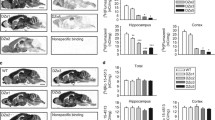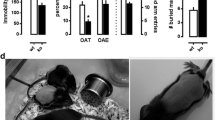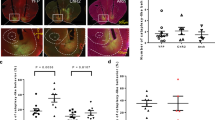Abstract
Rationale
Evidence suggests that γ-aminobutyric acid (GABA) and cholecystokinin (CCK) have opposite roles in the regulation of anxiety.
Objectives
The aim of our work was to study the behaviour of CCK2 receptor deficient mice in light–dark exploration and fear conditioning tests. Moreover, the action of diazepam and methyl-6,7-dimethoxy-4-ethyl-β-carboline-3-carboxylate (DMCM), having the opposite effect on GABAA receptors, was evaluated on the exploratory behaviour in these mice. Expression levels of GABAA receptor subunit genes were also measured.
Methods
Light–dark exploration and fear conditioning tests were used to determine changes in anxiety of mice. The action of diazepam (0.5–2 mg/kg i.p.) and DMCM (0.25–1 mg/kg i.p.) was studied in the light–dark box. The effect of DMCM was also evaluated in the motor activity test to demonstrate that its anti-exploratory action was not related to motor suppression. Expression levels of GABAA receptor subunit genes were determined by means of real-time polymerase chain reaction (qRT-PCR).
Results
Female mice lacking CCK2 receptors displayed increased exploratory activity in the light–dark box compared to their wild-type (+/+) littermates. Locomotor activity in the motility boxes and the intensity of freezing did not differ in wild-type (+/+) and homozygous (−/−) mice. Treatment with diazepam (0.5 mg/kg) increased the number of transitions in wild-type (+/+) animals, whereas in homozygous (−/−) mice diazepam (0.5–2 mg/kg) reduced exploratory activity. Administration of DMCM (0.25–1 mg/kg) induced an anxiogenic-like effect in homozygous (−/−) mice, but did not change their locomotor activity. Gene expression analysis established a 1.6-fold increase in the expression of the α2 subunit of GABAA receptors in the frontal cortex of homozygous (−/−) mice.
Conclusion
Genetic invalidation of CCK2 receptors induced an anxiolytic-like action in exploratory, but not in conditioned models of anxiety. The observed reduction in anxiety in homozygous (−/−) mice is probably related to an increased function of GABAergic system in the brain.





Similar content being viewed by others
References
Abramov U, Raud S, Kõks S, Innos J, Kurrikoff K, Matsui T, Vasar E (2004) Targeted mutation of CCK2 receptor gene antagonises behavioural changes induced by social isolation in female, but not in male mice. Behav Brain Res 155:1–11
Becker C, Thiebot MH, Touitou Y, Hamon M, Cesselin F, Benoliel JJ (2001) Enhanced cortical extracellular levels of cholecystokinin-like material in a model of anticipation of social defeat in the rat. J Neurosci 21:262–269
Bradwejn J, de Montigny C (1984) Benzodiazepines antagonize cholecystokinin-induced activation of rat hippocampal neurones. Nature 312:363–364
Chaouloff F, Durand M, Mormède P (1999) Anxiety- and activity-related effects of diazepam and chlordiazepoxide in the rat light/dark and dark/light tests. Behav Brain Res 85:27–35
Chesler EJ, Wilson SG, Lariviere WR, Rodriguez-Zas SL, Mogil JS (2002) Identification and ranking of genetic and laboratory environment factors influencing a behavioral trait, thermal nociception, via computational analysis of a large data archive. Neurosci Biobehav Rev 26:907–923
Contet C, Rawlins JN, Deacon RM (2001) A comparison of 129S2/SvHsd and C57BL/6JOlaHsd mice on a test battery assessing sensorimotor, affective and cognitive behaviours: implications for the study of genetically modified mice. Behav Brain Res 124:33–46
Cope DW, Maccaferri G, Márton LF, Roberts JDB, Cobden PM, Somogyi P (2002) Cholecystokinin-immunopositive basket and Schaffer collateral-associated interneurones target different domains of pyramidal cells in the CA1 area of the rat hippocampus. Neurosci 109:63–80
Cope DW, Wulff P, Oberto A, Aller MI, Capogna M, Ferraguti F, Halbsguth C, Hoeger H, Jolin HE, Jones A, McKenzie AN, Ogris W, Poeltl A, Sinkkonen ST, Vekovischeva OY, Korpi ER, Sieghart W, Sigel E, Somogyi P, Wisden W (2004) Abolition of zolpidem sensitivity in mice with a point mutation in the GABAA receptor gamma2 subunit. Neuropharmacol 47:17–34
Costall B, Domeney AM, Hughes J, Kelly ME, Naylor RJ, Woodruff GN (1991) Anxiolytic effects of CCK-B antagonists. Neuropeptides 19:65–73
Crawley J, Goodwin FK (1980) Preliminary report of a simple animal behavior model for the anxiolytic effects of benzodiazepines. Pharmacol Biochem Behav 13:167–170
Crestani F, Lorez M, Baer K, Essrich C, Benke D, Laurent JP, Belzung C, Fritschy JM, Luscher B, Mohler H (1999) Decreased GABAA-receptor clustering results in enhanced anxiety and a bias for threat cues. Nat Neurosci 2:780–782
Daugé V, Beslot F, Matsui T, Roques BP (2001) Mutant mice lacking the n receptor show a dopamine-dependent hyperactivity and a behavioral sensitization to morphine. Neurosci Lett 306:41–44
Davidson RJ, Irwin W (1999) The functional neuroanatomy of emotion and affective style. Trends Cogn Sci 3:11–21
Dawson GR, Rupniak NM, Iversen SD, Curnow R, Tye S, Stanhope KJ, Tricklebank MD (1995) Lack of effect of CCKB receptor antagonists in ethological and conditioned animal screens for anxiolytic drugs. Psychopharmacology 121:109–117
Dockstader CL, van der Kooy D (2001) Mouse strain differences in opiate reward learning are explained by differences in anxiety, not reward or learning. Neurosci 21:9077–9081
Farook JM, Zhu YZ, Wang H, Moochhala S, Lee L, Wong PT (2001) Strain differences in freezing behavior of PVG hooded and Sprague–Dawley rats: differential cortical expression of cholecystokinin2 receptors. Neuroreport 12:2717–2720
Fekete M, Lengyel A, Hegedüs B, Penke B, Zarandy M, Toth G, Telegdy G (1984) Further analysis of the effects of cholecystokinin octapeptides on avoidance behaviour in rats. Eur J Pharmacol 98:79–91
Ferraro L, Beani L, Trist D, Reggiani A, Bianchi C (1999) Effects of cholecystokinin peptides and GV 150013, a selective cholecystokininB receptor antagonist, on electrically evoked endogenous GABA release from rat cortical slices. J Neurochem 73:1973–1981
Harro J, Vasar E, Bradwejn J (1993) CCK in animal and human research on anxiety. Trends Pharmacol Sci 14:244–249
Hendry SH, Jones EG, DeFelipe J, Schmechel D, Brandon C, Emson PC (1984) Neuropeptide-containing neurons of the cerebral cortex are also GABAergic. Proc Natl Acad Sci U S A 81:6526–6530
Hernandez-Gomez AM, Aguilar-Roblero R, Perez de la Mora M (2002) Role of cholecystokinin-A and cholecystokinin-B receptors in anxiety. Amino Acids 23:283–290
Holmes A, Lit Q, Murphy DL, Gold E, Crawley JN (2003) Abnormal anxiety-related behavior in serotonin transporter null mutant mice: the influence of genetic background. Genes Brain Behav 2:365–380
Horinouchi Y, Akiyoshi J, Nagata A, Matsushita H, Tsutsumi T, Isogawa K, Noda T, Nagayama H (2004) Reduced anxious behavior in mice lacking the CCK2 receptor gene. Eur Neuropsychopharmacol 14:157–161
Hughes J, Boden P, Costall B, Domeney A, Kelly E,Horwell DC, Hunter JC, Pinnock RD, Woodruff GN (1990) Development of a class of selective cholecystokinin type B receptor antagonists having potent anxiolytic activity. Proc Natl Acad Sci U S A 87:6728–6732
Kõks S, Vasar E, Soosaar A, Lang A, Volke V, Võikar V, Bourin M, Männistö PT (1997) Relation of exploratory behavior of rats in elevated plus-maze to brain receptor binding properties and serum growth hormone levels. Eur Neuro-Psychopharmacol 7:289–294
Kõks S, Männisto PT, Bourin M, Shlik J, Vasar V, Vasar E (2000) Cholecystokinin–induced anxiety in rats: relevance of pre–experimental stress and seasonal variations. J Psychiatry Neurosci 25:33–42
Kõks S, Volke V, Veraksitš A, Rünkorg K, Sillat T, Abramov U, Bourin M, Huotari M, Männistö PT, Matsui T, Vasar E (2001) Cholecystokinin2 receptor-deficient mice display altered function of brain dopaminergic system. Psychopharmacology 158:198–204
Kosaka T, Kosaka K, Tateishi K, Hamaoka Y, Yanaihara N, Wu JY, Hama K (1985) GABAergic neurons containing CCK-8-like and/or VIP-like immunoreactivities in the rat hippocampus and dentate gyrus. J Comp Neurol 239:420–430
Livak KJ, Schmittgen TD (2001) Analysis of relative gene expression data using real-time quantitative PCR and the \(2^{{ - \Delta \Delta C}}_{T} \) method. Methods 25:402–408
Löw K, Crestani F, Keist R, Benke D, Brünig I, Benson JA, Fritschy J-M, Rülicke T, Bluethmann H, Möhler H, Rudolph U (2000) Molecular and neuronal substrate for the selective attenuation of anxiety. Science 290:131–134
Miller KK, Hoffer A, Svoboda KR, Lupica CR (1997) Cholecystokinin increases GABA release by inhibiting a resting K+ conductance in hippocampal interneurons. J Neurosci 17:4994–5003
Miyasaka K, Kobayashi S, Ohta M, Kanai S, Yoshida Y, Nagata A, Matsui T, Noda T, Takiguchi S, Takata Y, Kawanami T, Funakoshi A (2002) Anxiety-related behaviors in cholecystokinin-A, B, and AB receptor gene knockout mice in the plus-maze. Neurosci Lett 335:115–118
Möhler H, Fritschy JM, Rudolph U (2002) A new benzodiazepine pharmacology. Pharmacol Exp Ther 300:2–8
Nagata A, Ito M, Iwata N, Kuno J, Takano H, Minowa O, Chihara K, Matsui T, Noda T (1996) G protein-coupled cholecystokinin-B/gastrin receptors are responsible for physiological cell growth of the stomach mucosa in vivo. Proc Natl Acad Sci U S A 93:11825–11830
Nobel F, Wank SA, Crawley JN, Bradwejn J, Seroogy KB, Hamon M, Roques BP (1999) International Union of Pharmacology.XXI. Structure, distribution, and functions of cholecystokinin receptors. Pharmacol Rev 51:745–781
Paylor R, Nguyen M, Crawley JN, Patrick J, Beaudet A, Orr-Urtreger A (1998) Alpha7 nicotinic receptor subunits are not necessary for hippocampal-dependent learning or sensorimotor gating: a behavioral characterization of Acra7-deficient mice. Learn Mem 5:302–316
Perez de la Mora M, Hernandez-Gomez AM, Mendez-Franco J, Fuxe K (1993) Cholecystokinin-8 increases K(+)-evoked [3H] gamma-aminobutyric acid release in slices from various brain areas. Eur J Pharmacol 250:423–430
Pommier B, Beslot F, Simon A, Pophillat M, Matsui T, Daugé V, Roques BP, Noble F (2002) Deletion of CCK2 receptor in mice results in an upregulation of the endogenous opioid system. J Neurosci 22:2005–2011
Rasmussen K, Helton DR, Berger JE, Scearce E (1993) The CCK-B antagonist LY288513 blocks effects of diazepam withdrawal on auditory startle. Neuroreport 5:154–156
Raud S, Rünkorg K, Veraksitš A, Reimets A, Nelovkov A, Abramov U, Volke V, Kõks S, Vasar E, Matsui T, Bourin M (2003) Targeted mutation of CCK2 receptor gene modifies the behavioral effects of diazepam in female mice. Psychopharmacology 168:417–425
Rodgers RJ, Boullier E, Chatzimichalaki P, Cooper GD, Shorten A (2002) Contrasting phenotypes of C57BL/6JOlaHsd, 129S2/SvHsd and 129/SvEv mice in two exploration-based tests of anxiety-related behaviour. Physiol Behav 77:301–310
Sebret A, Lena I, Crete D, Matsui T, Roques BP, Daugé V (1999) Rat hippocampal neurons are critically involved in physiological improvement of memory processes induced by cholecystokinin-B receptor stimulation. J Neurosci 19:7230–7237
Shlik J, Vasar E, Bradwejn J (1997) Cholecystokinin and psychiatric disorders: role in aetiology and potential of receptor antagonists in therapy. CNS Drugs 8:134–152
Singh L, Field MJ, Vass CA, Hughes J, Woodruff GN (1992) The antagonism of benzodiazepine withdrawal effects by the selective cholecystokininB receptor antagonist CI-988. Br J Pharmacol 105:8–10
Tsutsumi T, Akiyoshi J, Isogawa K, Kohno Y, Hikichi T, Nagayama H (1999) Suppression of conditioned fear by administration of CCKB receptor antagonist PD135158. Neuropeptides 33:483–486
Vasar E, Peuranen E, Harro J, Lang A, Oreland L, Männistö PT (1993) Social isolation of rats increases the density of cholecystokinin receptors in the frontal cortex and abolishes the anti-exploratory effect of caerulein. Naunyn-Schmiedeberg’s Arch Pharmacol 348:96–101
Võikar V, Kõks S, Vasar E, Rauvala H (2001) Strain and gender differences in the behavior of mouse lines commonly used in transgenic studies. Physiol Behav 72:271–278
Võikar V, Vasar E, Rauvala H (2004) Behavioral alterations induced by repeated testing in C57BL/6J and 129S2/Sv mice: implications for phenotyping screens. Genes Brain Behav 3:27–38
Acknowledgements
This study was financially supported by the grants from the Estonian Science foundation (GARFS 5528, GARFS 5529, GARFS 5688), from the Estonian Ministry of Education and Science (0182584Bs03) and VARMC-TIPP.
Author information
Authors and Affiliations
Corresponding author
Rights and permissions
About this article
Cite this article
Raud, S., Innos, J., Abramov, U. et al. Targeted invalidation of CCK2 receptor gene induces anxiolytic-like action in light–dark exploration, but not in fear conditioning test. Psychopharmacology 181, 347–357 (2005). https://doi.org/10.1007/s00213-005-2255-x
Received:
Accepted:
Published:
Issue Date:
DOI: https://doi.org/10.1007/s00213-005-2255-x




